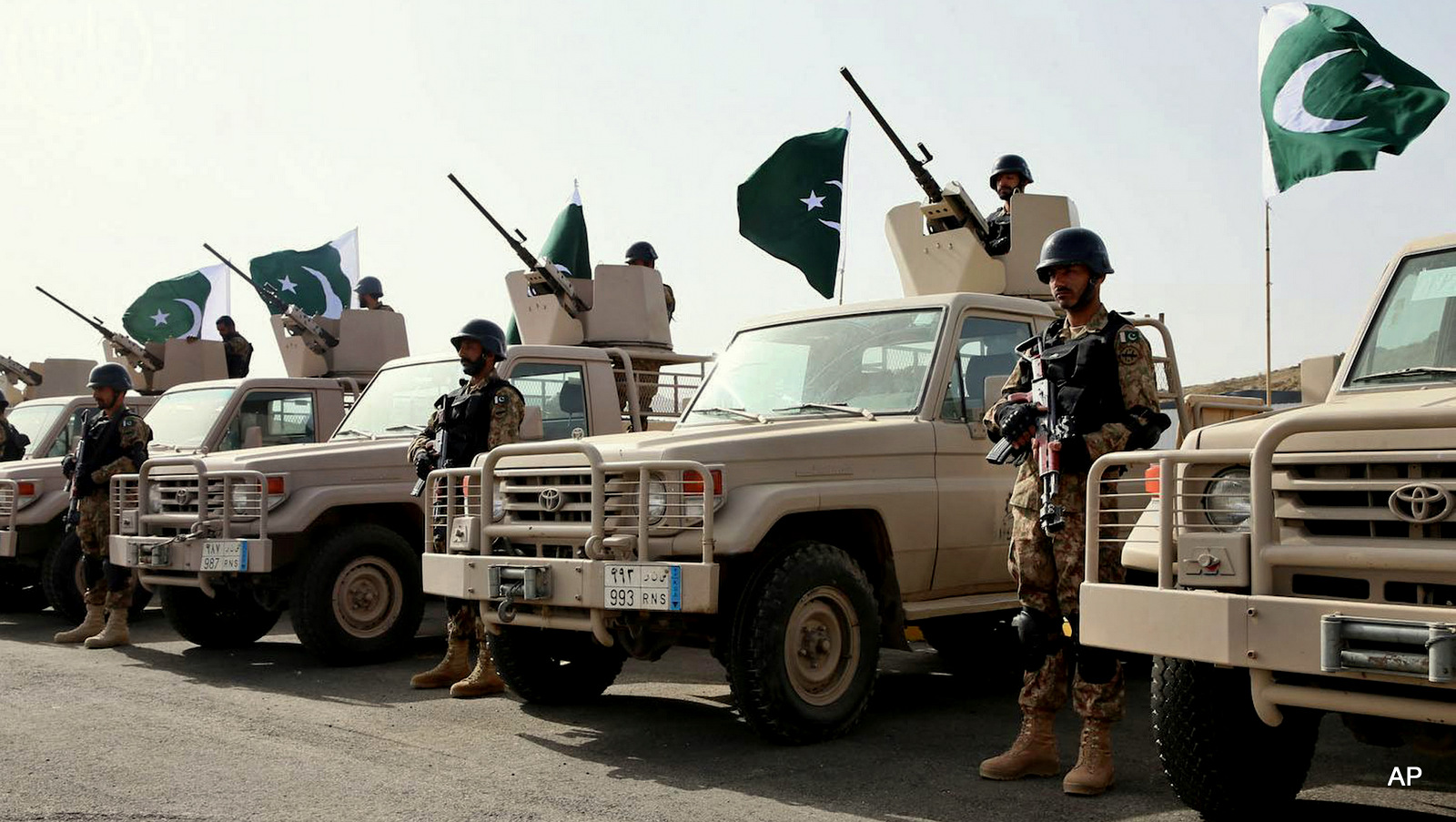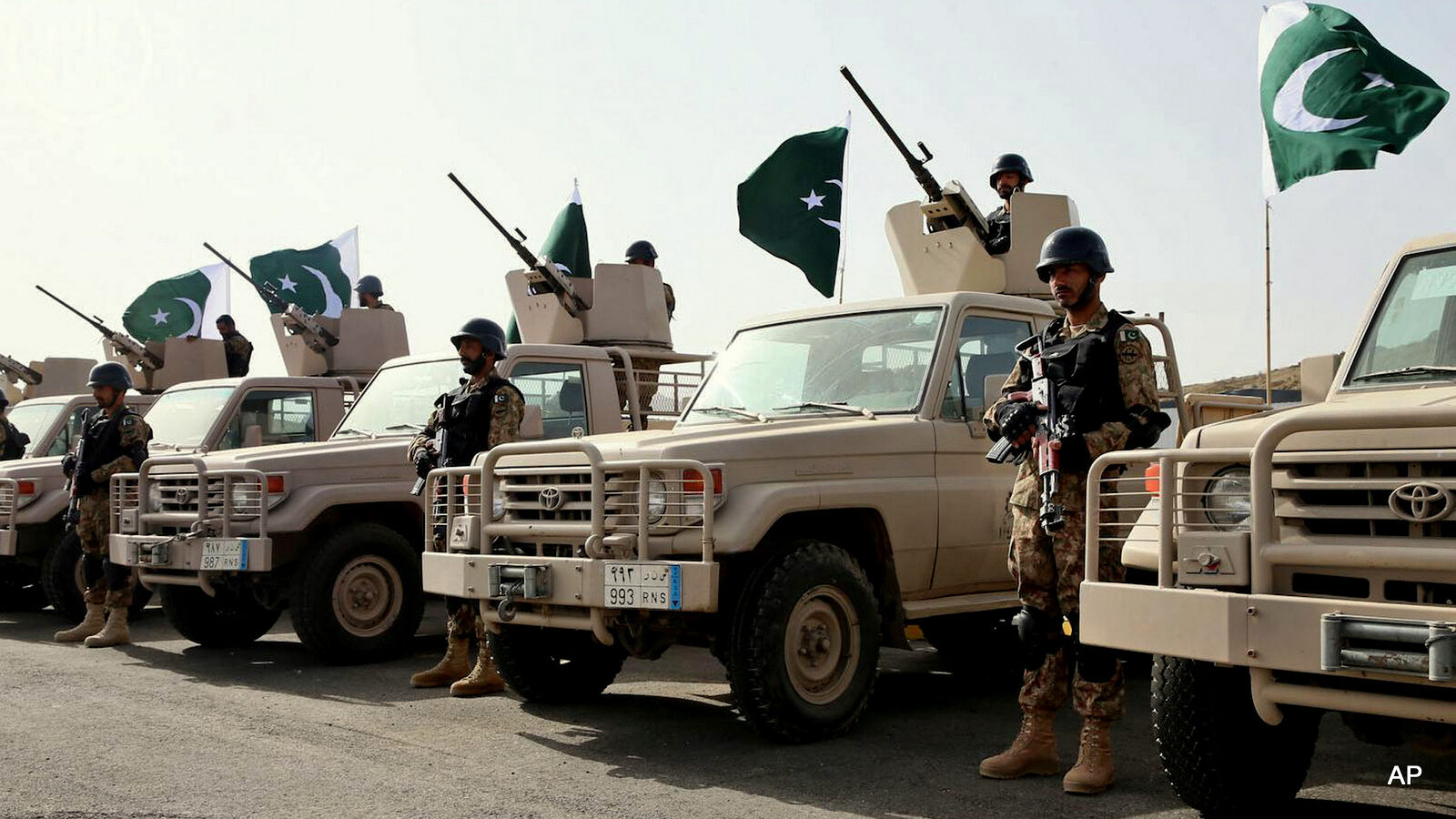 Royal Saudi Land Forces and units of Special Forces of the Pakistani army take part in a joint military exercise called “Al-Samsam 5” in Shamrakh field, north of Baha region, southwest Saudi Arabia.
Royal Saudi Land Forces and units of Special Forces of the Pakistani army take part in a joint military exercise called “Al-Samsam 5” in Shamrakh field, north of Baha region, southwest Saudi Arabia.
KARACHI, Pakistan — Earlier this month, the United States approved a $952 million sale of helicopters, missiles, engines, targeting and positioning systems, and other equipment in response to a request made by Pakistan last year to help its efforts to counter domestic insurgents.\
“This proposed sale will contribute to the foreign policy and national security of the United States by helping to improve the security of a country vital to U.S. foreign policy and national security goals in South Asia,” reads the certification by the U.S. Defense Security Cooperation Agency (DSCA) notifying Congress of the possible sale on April 6.
Yet national security may just be a pretext used for the swift clearance of this deal.
According to Stockholm International Peace Research Institute, selling arms may once have been “a major foreign policy and security tool” for the U.S., but this practice has been replaced by the need to prop up the U.S. arms industry at a time when the country’s own military expenditures have dropped.
“To sell or not sell weapons depends only upon political and strategic imperatives,” said Dr. Pervez Hoodbhoy, a professor of physics at the Forman Christian College University in Lahore, who is also a national security analyst.
Speaking to MintPress News, he added that that all arms suppliers, including the U.S., use human rights as a “fig leaf.” As an example of this, he pointed to the United States’ massive arms sales to Saudi Arabia, “which supports extremist groups across the world and mistreats minorities badly.”
“Today, given that Pakistan is fighting some Taliban groups instead of supporting them as earlier, it has become politically expedient and financially profitable for the U.S. to sell to Pakistan as well,” Hoodbhoy concluded.
Likewise, Commodore Uday Bhaskar, the director of the independent Society for Policy Studies in New Delhi and former head of the government-funded Institute for Defence Studies and Analyses (IDSA) and the National Maritime Foundation, a non-governmental think tank, noted the sale should be tied to “stringent conditions” on Pakistan’s army’s compliance with terrorism and human rights frameworks.
In 2014, global defense trade increased for the sixth straight year to $64.4 billion, up from $56.8 billion, with the U.S. and Russia topping the list of arms exporters. Soon after the approval of its sale to Pakistan, the U.S also approved a potential $57 million sale of air-to-surface missiles to Egypt.
According to IHS, a global information company, there has been “unparalleled demand from the emerging economies for military aircraft” since the escalation of “regional tensions” in the Middle East and Asia Pacific.
IHS’s Global Defense Trade Report, released in March, lists the top defense exporters and importers in 2013 and 2014 and shows how these rankings have changed year-on-year:
| Top Defence Exporters | Top Defence Exporters | ||||
| 2013 | 2014 | ||||
| 1. United States | 1.United States | ||||
| 2. Russian Federation | 2. Russian Federation | ||||
| 3. France | 3. France | ||||
| 4. UK | 4. UK | ||||
| 5. Germany | 5. Germany | ||||
| 6. Israel | 6. Italy | ||||
| 7. China | 7. Israel | ||||
| 8. Italy | 8. China | ||||
| 9. Sweden | 9. Spain | ||||
| 10. Canada | 10. Canada | ||||
| Top Defence Importers | Top Defence Importers | ||||
| 2013 | 2014 | ||||
| 1. India | 1. Saudi Arabia | ||||
| 2. Saudi Arabia | 2. India | ||||
| 3. UAE | 3. China | ||||
| 4. Taiwan | 4. UAE | ||||
| 5. China | 5. Taiwan | ||||
| 6. Indonesia | 6. Australia | ||||
| 7. South Korea | 7. South Korea | ||||
| 8. Egypt | 8. Indonesia | ||||
| 9. Australia | 9. Turkey | ||||
| 10. Singapore | 10. Pakistan | ||||
India’s race for arms
The Indian defense budget has increased to $40 billion, compared to a mere $7 billion for the neighboring Pakistani military. “India is claiming to be worried but its weapons purchases far exceed Pakistan’s,” Hoodbhoy asserted.
Meanwhile, the Chinese defense budget stands at roughly $145 billion, nearly four times that of India. In fact, China is second only to the U.S. in triple-digit military spending.
With India having made giant strides economically, it wants to flex its muscle and project itself to the world as a regional power. Experts say the arms buildup is related to India’s hostility toward Pakistan and represents its efforts to keep pace with China’s expanding military strength.
“For that it needs the wherewithal to modernize its armed forces and latest technology. It is in the process of replacing its weapon systems and equipment. Its long term defense plan envisages an expenditure of U.S. $10 billion annually for the next ten years,” said Lt. Gen. Talat Masood, who served in the Pakistan army for 39 years and retired as the secretary of defense production in the Ministry of Defense.
With India tailing Saudi Arabia as the world’s second-biggest defense importer, it is not surprising that Pakistan would feel threatened.
“It makes little sense for India to build up its arsenal to that level. Even if its forces are pitched against Pakistan, it does not need such a large inventory of conventional weapons that it is currently in the process of acquiring,” Masood told MintPress News over the phone from Islamabad.\
“If it cloaks the acquisitions by stating that these are meant for China it still does not make sense,” he continued, because the terrain is such that conventional weapons would not really be useful.
At the same time, the U.S. clearly does not want to upset India’s status as a major arms importer. The DSCA has taken pains to point out to the U.S. lawmakers that the sale would not “alter the basic military balance in the region.”
Western countries have, in the past, refused to export weapons to Pakistan for fear that it may offend India, experts say. This has prompted Pakistan to turn to China and become the latter’s biggest buyer, acquiring 41 percent of Beijing’s arms exports.
Earlier this month, Islamabad approved a deal to buy eight submarines worth $4 to $5 billion from Beijing. This would be the latter’s most expensive arms sale to date, eclipsing a deal for 50 JF-17 fighter jets bought by Pakistan in 2010 for more than $1 billion.
Nuclear-armed South Asian neighbors
While the U.S.-Pakistan arms sale was getting its final touches and stamp of approval, Maleeha Lodhi, Pakistan’s Permanent Representative to the United Nations, voiced Pakistan’s concerns over the expanding military expenditures and growing conventional weapons inventories, with “waivers and exemptions to long-held non-proliferation principles,” especially in South Asia, at the opening session of the U.N.’s Disarmament Commission in New York.
“Her [Lodhi] statement was directed towards India,” explained Masood. “And to show to the world the discriminating attitude the world is showing towards India; there is one standard for India and another one for Pakistan.”
With Pakistan remaining deeply suspicious of its main rival, India, the former counters India’s conventional superiority by maintaining strategic balance through its nuclear capability. “It provides a deterrent and takes care of the balance,” said Masood.
Pakistan will never be able to clear its blemished record of spreading nuclear technology to Iran, North Korea and Libya. Still, the nuclear weapons program remains a source of extreme national pride, and the scientist who headed the program for some 25 years, Dr. Abdul Qadeer Khan, is considered a national hero despite the shady transactions.
“Most of us are living hand-to-mouth and we are already a nuclear power, then I fail to understand why we are we still spending billions buying more weapons?” asked Mohammad Mirza, a father of eight, who works as a chauffeur in a private home in Karachi’s affluent Clifton area, earning about $145 a month.
Mirza’s thoughts are echoed by many in a country where the finance minister conceded last summer that half the population lives below the poverty line.
Dr. Hoodbhoy explained that while Pakistan’s army will always clamor for more nuclear weapons, it would not consider them particularly “useable” when it comes down to the brass tacks. “Actual fighting needs conventional — not nuclear — weapons,” and the latter merely raise “fear levels” and thus increase the “appetite for still more conventional weapons,” Hoodbhoy says.
The new deal may also raise awkward questions about the arms being diverted from fighting terrorism to bolstering Pakistan’s defenses against India. Much of the military equipment sold to Pakistan can be used on both its western and eastern borders, Hoodbhoy says. “This is in the very nature of such weapons,” he confirmed.
Commodore Bhaskar agrees that Pakistan is in need of “inventory assistance for its current counter-terrorism operations.” But he said the deeper Indian concern is that the Pakistan military “uses the military aid it receives against India, either in a covert manner (by supporting terror groups) or acquiring an edge in ordnance delivery and tactical surveillance.” For now, he said there has been no significant protest or public anxiety in India over the sale.
Defending Pakistan’s extravagant shopping list
U.S.-Pakistan relations have drifted in the past from Pakistan being chastised for its lack of commitment to fighting extremism to being deemed the most important ally of the U.S. With Pakistan’s assurance that the equipment it is buying will be used against “a common enemy,” Masood says for now it seems to have succeeded in allaying any misgivings Washington may have had.
Further, with Pakistan’s “improved” relations with U.S., he says it was relatively easy to get clearance for weapons acquisition.
The same assessment has been echoed in the U.S. “We have a very close counter-terrorism relationship with Pakistan for very good reasons,” said State Department Deputy Spokesperson Marie Harf. She added that the sale was in the “national security interest” in the tribal area of North Waziristan, where Pakistan’s army has been engaged in a full-scale military operation against militants since 2014.
As extremism and militancy continue to cast a shadow over Pakistan’s diplomatic and foreign policies, the U.S. continues to sell arms to Pakistan.
Many, including Masood, concede that Pakistan has not been able to root out extremism completely. “It has made progress, though,” he said.
Yet he also asked whether any country has been successful in eliminating extremism. He says not being able to stem militancy doesn’t mean Pakistan shouldn’t acquire modern weapons and equipment to replace outmoded ones.
In addition to militancy, though, Pakistan also has a dubious human rights record and its treatment of the country’s minorities continues to make global headlines. These are factors that seem to have been overlooked in the latest deal with the U.S.
“It’s true that we have a dismal human rights scores and it is often set aside when the United States’ own national interest comes in play,” Masood said.


